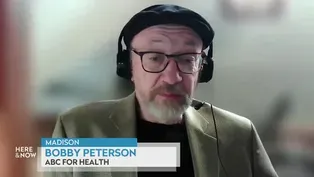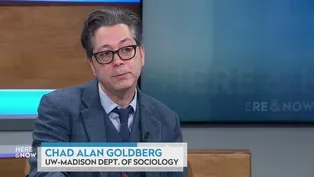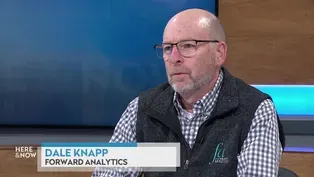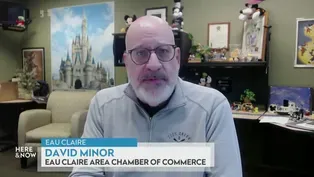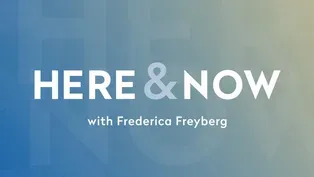Here and Now
Here & Now for January 10, 2025
Season 2300 Episode 2326 | 26m 49sVideo has Closed Captions
Watch the entire episode of Here & Now for January 10.
Watch the entire episode of Here & Now for January 10.
Problems with Closed Captions? Closed Captioning Feedback
Problems with Closed Captions? Closed Captioning Feedback
Here and Now is a local public television program presented by PBS Wisconsin
Here and Now
Here & Now for January 10, 2025
Season 2300 Episode 2326 | 26m 49sVideo has Closed Captions
Watch the entire episode of Here & Now for January 10.
Problems with Closed Captions? Closed Captioning Feedback
How to Watch Here and Now
Here and Now is available to stream on pbs.org and the free PBS App, available on iPhone, Apple TV, Android TV, Android smartphones, Amazon Fire TV, Amazon Fire Tablet, Roku, Samsung Smart TV, and Vizio.
Providing Support for PBS.org
Learn Moreabout PBS online sponsorshipThe following program is a PBS Wisconsin Original production.
>> A new Year ushers in a new legislature at the State Capitol and a new Congress in Washington.
But echoes of an insurrection four years ago reverberate in today's political divide.
[MUSIC] on "Here& Now", we take a closer look at the core issue.
Growing that political divide.
[MUSIC] could ease the impact of medical debt.
News of hospital closures rocked central Wisconsin one year ago.
How was the area faring?
And the threat of a declining population has experts looking 25 years into the futur?
It's "Here& Now" for January 10th.
provided by the Focus Fund for Journalism and Friends of PBS Wisconsin.
>> Nearly 1600 people have been charged for their actions at the charged for their actions at the storming of the nation's capitol on January 6th, 2021, in the largest investigation in U.S. History.
All of them could be pardoned by president elect Donald Trump as he prepares to take office in ten days.
11 Wisconsin residents have been convicted on charges ranging from unlawful entry on restricted grounds to assaulting officers while armed with a dangerous weapon.
One man serving a three year sentence in federal prison pepper sprayed officers bragging in a Facebook message, quote you charge that line and start spraying.
They start running for cover like you're coming at them with an A.
What leads someone to violently breach the U.S. Capitol?
Four years later, president elect Donald Trump speaks of pardoning insurrectionists because he saw January 6th as a day of love.
Whether that or a day of shame, what particularly drives his supporters all the way to his reelection?
Research into that may surprise you.
Here to discuss is UW-Madison professor of sociology Chad Allen Goldberg.
And thanks very much for being here.
>> Thank you for having me.
>> So the kind of running political theory has been that Donald Trump won reelection on the message of fixing inflation and the economy.
But but describe what you researched and what it showed.
>> Yeah.
Well, we tested three theories.
So one is this economic populism theory.
A second theory is what we call a kind of political alienation theory, which we try to distinguish from the first one.
So if the first one is about economic grievances, the second one, the idea here is that people support political outsiders like Mr. Trump, because they're alienated from political institutions or from government.
They feel like they're not.
Well represented or that these institutions are not looking out for people like them.
And then a third theory that we tried to test is a kind of a status threat theory.
So basically the idea here is that demographic changes in American society, cultural changes in American society, have threatened the status of dominant groups in our society.
And that that is what's driving support for Mr. Trump.
Now, none of these theories are mutually exclusive.
It could be combination of things, right?
The theory that we found the most support for is this status threat theory.
So we looked at indicators of status threat and the survey data.
So for example, people who say who are asked the question, do you agree with the statement that cultural, racial diversity is important for America?
Sort of what they say in response to these kinds of questions.
Questions about religion, questions about gender, why is it important to understand this?
I think it's important because as, as as virtually everyone recognizes, since 2016, there's been dramatic changes in American politics and when Mr. Trump won the 2016 election, people could say, well, maybe this is an aberration.
Maybe after this, when Mr. Biden was elected in 2020.
Maybe there's a return to normalcy.
But it seems clear, given Mr. Trump's reelection in 2024, that there are fundamental changes afoot in American politics.
So as political sociologists, we think it's important to try to understand what are the forces, what are the mechanisms driving this and how they're reshaping American politics.
So the breach on the US Capitol began with the Trump led conspiracy that the 2020 election was stolen.
>> How was that kind of outsized response informed by a threat to people's status?
>> Yeah, I think one of the key factors here is feelings about immigration.
So American immigration law was reformed in 1965.
This led over time to significant flows of immigration from new sources into the United States.
This took decades for the effects to fully manifest.
It was a gradual process, but there are significant.
There are significant changes going on in terms of the in terms of the proportion of Americans who are foreign born for example, some people have compared the current situation to the situation in the United States in the early 1900s, when there was also a major upsurge of nativism, leading to the national origins, quotas legislation.
In 1921 and 1924, which essentially slammed the doors for immigration for decades.
So we think it's connected to this theory of status threat.
And in that way, and I have seen some research indicating that among those who participated in the January 6th insurrection, motivations.
Key motivations included the idea, the belief that the 2020 election was stolen and also concerns about immigration.
So we think that this is something that's that's consistent with the status threat theory.
>> So the status threat theory.
According to your paper, includes features of racism, sexism, xenophobia, as well as cultural and moral traditionalism.
Yeah.
I mean, to put it bluntly, yeah, I think it's important to emphasize that the way that we conceive this, it's a combination of several different sorts of status threats.
>> So sometimes people will want to say, wow, Trump.
Mr. Trump was elected because of racism in the electorate or among his supporters, or because of sexism or because of Islamophobia or Christian nationalism.
Are the kinds of things we thought.
It's important to look at these various kinds of status threat together, and to see how they might be coming together to reinforce a sense of being under siege among some Americans.
>> How does history treat January six?
>> That remains to be seen.
Of those voters who say they think American democracy is under threat, roughly half of them supported Mr. Trump.
This, I think, is a very troubling and a very dangerous situation that the reactions to January 6th, the insurrection are so divided along partisan lines.
But I think we can say that if trends continue the way that they are and especially if Mr. Trump follows through with his vow to pardon those who were convicted in the January 6th insurrection, this will simply exacerbate and worsen the situation that have described.
It will deepen the partisan division around this, and it will make it even less likely that January 6th will lead to some kind of national unity and resolve.
Unfortunately.
All right.
>> Chad Allen Goldberg, thanks very much.
>> Thank you to letters keep coming to you from the hospital about the balance you owe.
>> Well, this week, the Biden administration announced unpaid medical bills will no longer appear on credit reports removing $49 billion in such debt from the credit reports of 15 million Americans.
And nearly 400,000 people in Wisconsin.
Medical debt lowers credit ratings, preventing people from getting loans, renting apartments, even getting a job here with his reaction, attorney Bobby Peterson from ABC for health, a nonprofit public interest law firm in Madison, and Bobby, thanks for being her.
>> Thanks for inviting me.
Appreciate it.
>> So when you heard about this, what was your reaction?
>> I thought it was great.
I think, you know, getting medical debt off of people's credit report is a real positive move in the right direction.
You know, a lot of times people don't choose to get ill or sickness or working with a family member that has big bills because of illness or sickness.
And to have that compromise your credit report.
I think, is just in the wrong direction.
It's not a good indicator of credit worthiness.
Oftentimes.
So removing it, I think is definitely a move in the right direction.
>> You call the current system an electronic debtor's prison.
How so?
>> Well, if you think about it, you know, in the old days they would you didn't pay your bills.
They locked you up and threw you in prison until you paid your bills.
Today it's a situation where you have electronic handcuffs on and electronic debtor's prison.
It's your credit score.
If your credit score doesn't meet the certain metrics that people want, you can't get a car apartment.
You can't get a job sometimes.
And so it really is an electronic debtor's prison that traps people sometimes in poverty, by eliminating medical debt from this equation, I think it can lift a lot more people out of this.
Electronic debtor's prison.
And give them an opportunity to move forward to get credit.
Apartment jobs, things like that.
I mean, the estimates are that people's by removing medical debt from their credit scores, could raise their credit score by up to 20 points.
>> So what incentive, though, remains for getting people to pay their medical bills?
>> Well, I mean, I think that, you know.
Part of the issue with medical bills is that we have such a confusing, complicated system that trying to understand it and figure it out at the front end is extraordinarily difficult for most.
Consumers, particularly if you're sick, if you're helping a family member trying to work through that, it's impossible.
What a lot of people don't understand is that those decision makers are saying no to coverage.
That usually results in bills that aren't paid.
And so when those bills don't get paid, it's a cost for all of us.
We've talked before about, you know, the hospital association does an annual uncompensated care report in Wisconsin that uncompensated care report was about $1.4 billion in 2023.
That's money that just isn't getting paid.
We also know that that medical billing and medical debt, sometimes there's so many mistakes made in the process that people are billed inappropriately.
So again, it's not a good measure sometimes of someone's credit worthiness because errors mistakes our solution to this is to really work at the front end of the process, try and help people avoid that medical debt before it becomes a bill.
Streamline the system and simplify the system a little bit more in your experience with clients, how does the debt mostly accrue and mostly for whom?
For a lot of people that have ongoing chronic medical conditions, people that have children with special health care needs, adults with disabilities because they are high users of the system, they end up getting in those more encounters result in more bills and medical debt.
And, you know, it's not just hospital debt.
It's prescription drug debt.
It's going to physicians.
It's going to physician groups, dental bills, all of that accumulates.
And it just becomes a lot for people to try and deal with and try and work through.
>> So this is a Biden rule.
How likely might it be that it's overturned by the incoming administration?
I'd say there's a good chance that it might get overturned.
that's going on right now is filed a day after the rule was published, and the rule doesn't take effect until 60 days after publication.
So the rule was published on Monday, 60 days later.
The rule will take effec.
A lawsuit was filed in Texas.
So we've seen this before.
So a little bit of venue shopping there to find a judge that might be likely to overturn it.
We don't know that that's going to happen, but we suspect that was part of the strategy.
We also know that the congressional Review Act gives Congress an opportunity to review these administrative rules within 60 days to be able to overturn them.
It has to be approved by the House.
The Senate, and signed by the president.
There's very narrow margins.
So, you know, medical debt is one of those issues that does have some bipartisan appeal.
So maybe it'll make it through.
But I'm not I'm not super optimistic about that.
>> All right.
Well Bobby Peterson, thanks very much.
>> You're welcome.
>> It was just about one year ago.
That Sacred Heart and Saint Joseph's hospitals in Eau Claire announced they would close along with Prevea clinics in the region.
About a month later, Governor Tony Evers signed legislation to provide $15 million for Western Wisconsin hospital funding, but that money has been tied up over political fights and landed in the courts after Evers sued for release of the money.
>> The last budget on this was not what the people in Eau Claire, at least the ones that talked to us and that included health care folks.
They wanted a broader use of that money.
So no, I mean, we're well past the ideas somehow I'm going to undo that veto.
We need to get that money out joint finance Committee does not have the legal authority to do what they did.
And so we're looking forward to a resolution in cour.
>> So western Wisconsin has yet to see the $15 million to help shore up health care access.
But in the intervening months the region has stepped up.
Without it, the Eau Claire area Chamber of Commerce formed a recovery task force right after news of the hospital and clinic closure.
David Minor is president and CEO of the Chamber.
He joins us now with an update on how health care needs are being met.
Nearly a year after the hospitals pulled out.
And David, thanks very much for being here.
>> Absolutely.
Good morning to you.
>> Well, what happened in the last year to help fill the void of these closures?
Well, really several things took place.
>> You know, once we stepped up the task force, Mayo Clinic, Marshfield Clinic, Oak Leaf Clinic, they really took on the brunt of trying to absorb as much as they can.
And again, we knew going into that that there was no way they could absorb all of it.
But once we had a handle on what they could do and the expansions of their work, then we tried looking at other entities, other businesses that could come to the area and start to fill in some of those other pieces.
So it's been a slow process.
It still happening as we talk, but it's we're we certainly haven't recovered fully, but we're we're in a good shape.
Overall.
I would say.
But still a lot of work yet to be done.
And there are even new hospitals being envisioned to be built.
Correct.
So again, oak leaf network, what they did is they formed a coalition of co-o.
They are currently looking at building a new hospital.
They have found a location in the Lake Haley area between Eau Claire and Chippewa Falls.
They've been doing a lot of due diligence.
They're also currently looking at standing up Saint Joe's Hospital up in Chippewa Falls, which would be a bridge from now to when the new hospital and they're fundraising takes place.
And the it spirals out of Wausau is looking at building a hospital up in the Chippewa Falls area.
So again, a lot going on.
You know, a lot of it for us in the task force is standing back and allowing them all the opportunity to do what they need to do.
But for us, it's about, you know, when we look at going down in March for our Chippewa Valley rally.
Making sure that when we talk health care, we're very specific about what are we asking for and what those entities may need to help them continue that expansion and or to grow their capacity to be able to handle all of the issues that still need to be resolved.
>> What are you asking for specifically?
>> That's a magical question.
I don't necessarily have an answer to it, but what we're looking at is what will those entities nee?
Are there pilot programs per se that could be launched here?
Also, one of the things that has has been launched in this area is a rural health care initiative, looking at what is rural health care going to look like in the future, and can we help develop it here?
So part of that may be going down looking for funds to help invest in tha.
We will have probably a better answer to that question in the next 30 days or so.
But really, working with all those partners to understand what do you need, how do we put that together as a region and make that one large request?
>> I know that there are still gaps in care in the region.
Notwithstanding all of these entities standing up, you know, in this way, you mentioned birthing centers.
What's the situation there?
>> Again, we in the beginning, Marshfield took on more, Mayo took on more, and things.
But that gap hasn't completely filled.
So we do know and we have heard stories that we're expectant mothers have had to either be taken up to Duluth, over to the Twin Cities, other areas, so that is, you know, outside of some of the cancer patients as well.
Those are areas we know that need some.
Immediate concerns to be addressed.
So we're not having to ship them out of our area.
>> We talked earlier in this program about medical debt and charity care.
How sustainable in your mind is the health care industry.
Between that and reimbursements for that care, I think one of the things that has to happen is an honest discussion in Washington, D.C, and Madison about reimbursement rates for Medicare and Medicaid.
>> It just it has to happen.
They're not sustainable.
You know, you can't tell a business to only charge 40 some percent or 50% on the dollar and expect it to last long term.
We know that that was part of the reason why Hshs had left.
So that conversation has to take place.
But we're also looking at some in Wisconsin.
We're looking at some other opportunities.
Are there ways for us to free up more federal dollars that are already there, but that could be brought back to our state?
And again, that may be done on a pilot program.
>> Okay.
Just briefly, what has this past year been like for patients, providers and citizens?
There?
I don't think people really, truly understand the impact of losing to hospitals and 7 or 8, ten clinics.
a lot of anxiety, a lot of sleepless nights, but also, I don't think everybody understands how well this community and this region pulled together to do everything we could to make it the best we could.
It wasn't perfect and is not, but I cannot thank the people in this area enough for what everybody has done from all sides, to get us to this point.
All right, David Minor, thank you very much.
Thank you.
Have a good day.
>> Wisconsin's population is on a steep decline.
The latest projection from the state Department of Administration shows Wisconsin's population is expected to decline by nearly 200,000 residents by 2050.
It's all about aging and babies and migration in and out of the state.
But what are the implications for Wisconsin in the face of a population drop off?
We turn to Dale Knapp, director of forward Analytics.
And thanks very much for being here.
>> So we just kind of named what we think is going on, but what are the drivers of population decline in Wisconsin?
>> Well, you know, the baby boomers that, that that demographic, you know is one of the drivers that they're now entering their, their later years.
But really the big the two big drivers of this population decline that we're now beginning to, to see is the lack of, of babies.
We've seen the number of births drop every year, but two since 2007.
The births in 2000, 23 were the lowest since 1942.
That's amazing.
And then the other piece is the other component is migration.
We saw big net migration into the state, into the 1990s, and it's lagged ever since.
And when you have the demographics that we do kind of baked into our future growth or no growth, you need migration into the state to fill those gaps.
And we're not seeing that.
>> Where are population declines happening fastest in the state?
They're happening fastest in the rural North.
>> You know, they've been that's been going on for 20 years.
Slow growth and then some decline.
We saw a bump in this last decade in the census in a number of counties in the north.
But it was really all baby boomers that have retired moving north, which doesn't help for workforce.
And those key things that they need to, you know, for, for their economy.
But, you know, as they age, that's going to, you know, they're going to move on as well.
So, so certainly people have been talking about this for a long time.
>> We have known it has been coming, but is it worse than expected in your mind?
>> No, I don't I think it's a little bit worse because of the decline in births.
Births generally move up and down in kind of cycles.
And when birth started to decline in 2007, I think most demographers thought, you know, that was going to be temporary.
It was going to be, you know, six, seven, eight, ten years.
And it's not been it's continued.
And it's happening.
Happening everywhere.
And unfortunately, there's really no signs that that's going to change in the near future.
And so I think that's the that's the part that has sort of surprised us over, over the past, you know, 5 or 6 years and has made the projections as you look out, look, you know, much worse.
>> So what are the implications for population drop offs of this magnitude?
>> Well, you know, there there there's a lot of implications.
I think the number one that you look at is workforce.
Our 25 to 64 year old population is expected to decline by almost 200,000.
Just in this decade.
And then more over the following couple of decades.
We're already looking at labor shortages everywhere throughout the state, so it's not only going to continue, it's likely to get worse.
And then when you look a, you know, especially the declines in births, the impact there on schools whose funding is tied to enrollment, we're likely to continue to see declining enrollment there.
And financial challenges for our schools.
>> So meanwhile, Dane County is the total outlier with big projected population gains by 2050.
What sets Dane County apart, and can it be replicated?
>> Well, I think you know, one of the.
Dane County is unique in that it has both.
It's the home of state government and it has the major university.
And I think when you look around the country, you'll see that those counties that have that are generally more prosperous and growing and so Dane County has all of that.
It kind of makes it a little bit recession proof to some degree, because you don't have the economic fluctuations of laying off people as much with with government.
And so that's that's part of it.
But it's also, you know, it's become a place that has a lot to offer in terms of recreation and activities and restaurants.
ET cetera.
And so people look at it and, you know, they see it as a, as a great place to, you know, raise their kids whether they want to be in a more urban area.
Madison, Or in one of the a little bit more outlying communities.
We will obviously be watching these numbers.
Doyle Knapp.
Thanks very much.
Thanks for having me.
For more on this and other issues facing Wisconsin, visit our website at PBS Wisconsin.
Org.
And then click on the news tab.
That's our program for tonight.
I'm Frederica Freyberg.
Have a good weekend.
[MUSIC] >> Funding for "Here& Now" is provided by the Focus Fund for journalism and Friends
Bobby Peterson on Removing Medical Debt From Credit Reports
Video has Closed Captions
Bobby Peterson on the scale of medical bills and a rule to block debt on credit reports. (5m 27s)
Chad Alan Goldberg on Populist Politics and Jan. 6's Legacy
Video has Closed Captions
Chad Alan Goldberg on researching the rise of populism and the impacts of Jan. 6. (17m)
Dale Knapp on a Projected Population Decline for Wisconsin
Video has Closed Captions
Dale Knapp on factors contributing to a projected population decline in Wisconsin by 2050. (5m 43s)
David Minor on the Chippewa Valley's Health Care Needs, Gaps
David Minor discusses efforts to expand hospital and clinic facilities after closures. (6m 51s)
Here & Now opening for January 10, 2025
Video has Closed Captions
The introduction to the January 10, 2025 episode of Here & Now. (1m 7s)
Providing Support for PBS.org
Learn Moreabout PBS online sponsorshipHere and Now is a local public television program presented by PBS Wisconsin
